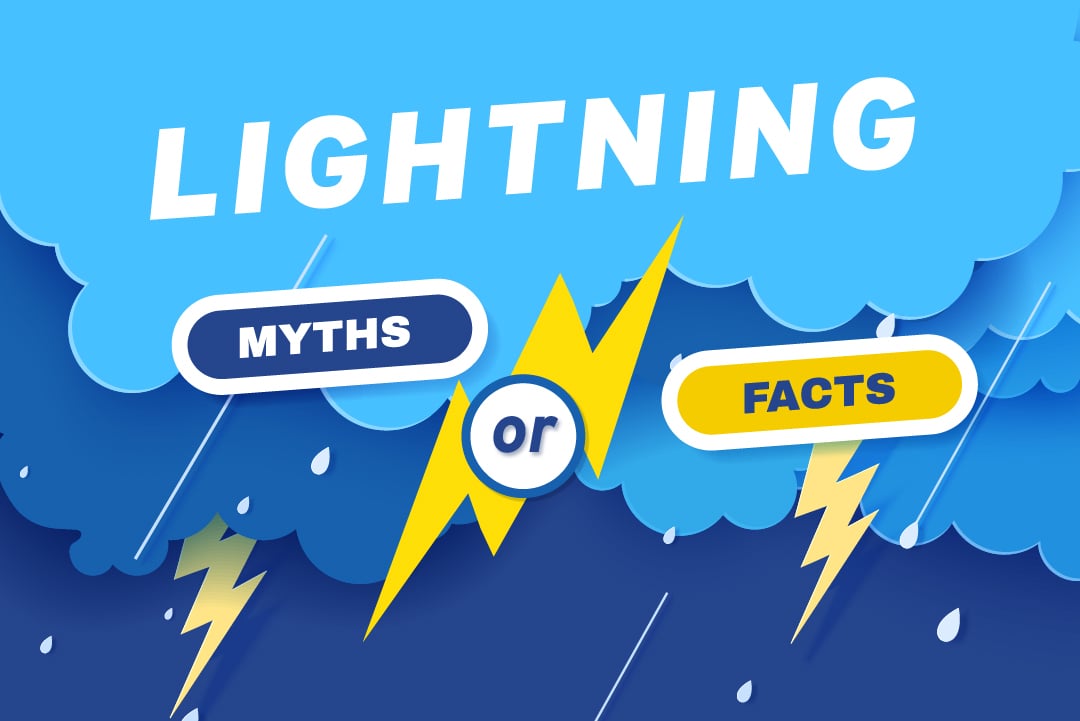
Lightning is one of nature’s most awe-inspiring phenomena, and we get a lot of it in Florida! On average, the state sees around 70-100 days a year with at least one thunderstorm, making lightning one of the deadliest weather hazards in the Sunshine State.
But lightning is also shrouded in myths and misconceptions. Let’s zap the myths and learn how to stay safe!
Myth: Lightning Never Strikes the Same Place Twice
The truth is, lightning doesn’t hold grudges or keep score. In fact, it’s quite the repeat offender! The path of lightning is determined by factors like conductivity and atmospheric conditions, not a quirky sense of fairness.
Myth: You’re Safe Indoors During a Storm
You are safer indoors than outdoors, but that doesn’t mean you’re invincible. Avoid using wired electronics, plumbing, and anything that connects to the outside world, because lightning can travel through electrical and plumbing systems. That means no showers, no washing dishes, and definitely no plugging in that blender for a quick smoothie.
Myth: Rubber Tires on a Car Will Protect You
Time to burst this bubble: it’s not the rubber tires that keep you safe in a car. It’s the metal frame of the vehicle that directs the lightning around you and into the ground.
Myth: Lightning Only Strikes When It’s Raining
Just because it’s not pouring doesn’t mean you’re in the clear. Lightning can strike miles away from the center of a storm, even under clear skies. This is what’s called a “bolt from the blue.” So, if you hear thunder, it’s time to head indoors, no matter how sunny it looks.
Myth: If You Lie Flat on the Ground, You’re Safer
When caught outside with nowhere to go, dropping to the ground might feel like a safe bet. Spoiler alert: it’s not. Lying flat increases your contact with the ground and, consequently, your chances of being affected by ground current. Instead, crouch down on the balls of your feet, tuck your head, and make yourself as small as possible.
Myth: You’re Safe Under a Tree
Trees might seem like natural lightning rods that could protect you. Unfortunately, seeking shelter under a tree is one of the worst ideas during a thunderstorm. Trees can explode or catch fire when struck, and the ground current can travel outward, hitting anything nearby – including you. If you’re caught in the open, find a low spot away from trees, metal fences, and tall objects.
Myth: Metal Attracts Lightning
Metal doesn’t attract lightning, but it does conduct it. Wearing metal jewelry or having metal objects nearby won’t make you more likely to be struck, but if lightning does hit near you, metal can conduct electricity. So, while ditching the bling won’t save you, avoiding metal structures and objects during a storm is wise.
Myth: It's Safe to Talk on a Landline Phone
Corded phones are NOT safe to use during a thunderstorm. Do NOT use them. However, it is safe to use cordless or cellular phones during a storm.
Now that you know the common myths surrounding lightning, here are some quick reminders on staying safe. Strike up a conversation with your friends and loved ones, and help spread the word!
- When Thunder Roars, Go Indoors: If you can hear thunder, lightning is close enough to pose a threat.
- Stay Inside: Remain indoors for at least 30 minutes after the last clap of thunder.
- Avoid Plumbing: No showers, baths, or washing dishes during a storm.
- Unplug or Avoid Devices: Stay away from corded phones and electronics.
The truth about lightning is more electrifying than the myths. Stay safe, stay smart, and next time a storm rolls in, you’ll be ready to weather it!
